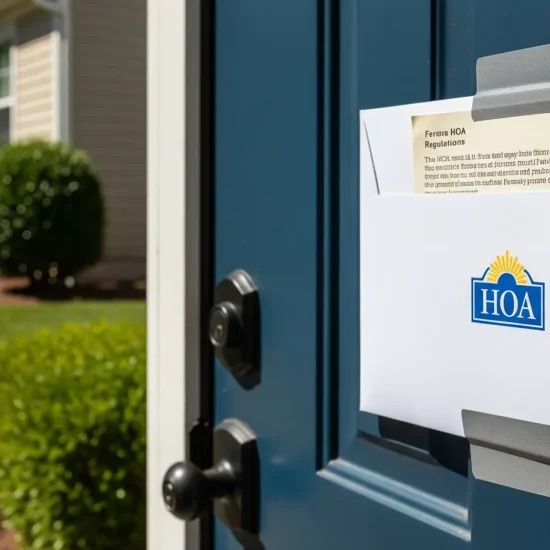
HOA Detective | June 10, 2025 | In the early 1980s, Savings & Loan (S&L) associations were considered boring, low-margin, and low-risk businesses. S&Ls quietly served American homebuyers, collecting deposits and issuing fixed-rate mortgages but nobody attended college with the goal of graduating with a business degree so they could pursue a career as the manager of the local S&L, in other words, nothing about S&Ls could be termed a “sexy business.”
Despite this, it is entirely possible that your childhood home, that of your grandparents, and half the people you knew in 1980 were bought using a mortgage extended by the local S&L.
Few people thought S&Ls faced any systemic danger in 1980 when former California Governor Ronald Reagan was elected President of the U.S. for the first time. Not until the deregulation of S&Ls by Reagan, rising interest rates, and greed raised their ugly head and turned these “safe” institutions into financial powder kegs. At that point, all bets were off!
Fortunes Lost. Fortunes Won: During the decade of the 1980s, over 1,000 S&Ls failed while U.S. taxpayers were left with an initially reported $124 billion bailout bill. The final cost was closer to $160B and will never be known; what is known is that the usual cabal of suspects lined up at the financial watering trough known as the USGOV’s Resolution Trust Corporation (RTC) in much the same way they did during the recent Covid-19 pandemic.
When the curtain was finally closed on that ugly chapter of American business, the most prominent players in that game of cat & mouse had amassed fortunes estimated to be in the BILLIONS! All at the expense of U.S. taxpayers!
Four Decades Later: The HOA management industry may be playing a quieter version of the same song. HOAs – private nonprofit corporations that govern residential communities – now oversee more than 350K communities in the U.S. Collectively, these HOAs contain close to 27M homes in which 77M Americans live. These largely unregulated HOAs collect more than $100 billion in assessments annually and manage an estimated $6B in replacement reserve funds.
Most HOAs hire third-party management firms to collect dues, manage vendors, and prepare budgets. These firms operate on tight margins (often 10% – 15%), fueling an industry consolidation trend. Big national players like Associa and FirstService Residential dominate the market.
A Perfect Storm is Brewing: Much like S&Ls in their prime, HOA management companies (ManCos) are widely perceived as low-risk intermediaries operating a routine service business. But beneath the surface lies a fragile ecosystem of volunteer board governance, nonexistent and/or fragmented oversight. Amid this confluence lies any number of vast pools of poorly monitored money.
In other words, exactly the type of environment that has historically given rise to financial scandals, massive fraud, loss of billions, and the occasional prison sentence when regulators and prosecutors awaken from their slumber, and are forced to act.
Only seven states require HOA managers to be licensed. In most of the country, anyone can become a community manager – no credentials needed. Volunteer HOA boards, often lacking financial or legal expertise, are expected to supervise vendors, safeguard reserve funds, and navigate infrastructure decisions worth millions.
Set Up Ripe for Failure: Failures in this ecosystem have occurred in the past. Not always reported as above-the-fold news, but stories nonetheless. In this Feb 2025 report, Colorado ManCo, Mastino Management was caught after siphoning over $2 million from HOA accounts.
Ghost Vendors & Quiet Decay: In a case now more than a decade old, a California ManCo was caught red-handed after embezzling more than $900K of HOA funds by channeling the money through a series of “ghost vendor” companies.
Other communities teeter on insolvency with deferred repairs and underfunded reserves. This corruption isn’t always criminal in nature. Sometimes it is more a case of quiet institutional decay:
- Ill-informed Boards that underfund reserves for decades.
- Managers who cut corners on maintenance to keep their margins.
- Consultants who frontload expenses to benefit friendly contractors.
Been There. Done That! The current situation within the HOA management arena mirrors what happened to S&Ls when the industry was deregulated after the election of Ronald Reagan in 1980. The result of this deregulation effort was that a structure designed for stability became overwhelmed by financial incentives and weak regulatory oversight. In this case, the “boring” veneer attributed to S&Ls masked increasingly reckless behavior among certain prominent players. When the cracks initially appeared, most industry observers discounted their importance. Five years and $160B later, more than 1,000 S&Ls had been declared insolvent.
Size Matters: The 1980s S&L disaster taught us that scale matters. What starts as small-scale misconduct can cascade into full-blown systemic failure when duplicated across thousands of institutions. When the sum is exponentially greater than the individual loss to one financial entity, the criminal-minded element tends to take notice. HOAs, like S&Ls, are small individually, but collectively, they govern one-quarter of the U.S. housing stock. That’s tens of millions of Americans depending on an under-regulated financial ecosystem.
Along Comes Trump, the Tariff King: In the wake of the Surfside condo collapse in Florida, lawmakers have begun responding. New laws require inspections and reserve funding. Some states, like Colorado, are reconsidering the licensing of managers, but most of the country remains vulnerable. With the dust from the Champlain Tower collapse only recently starting to settle, along comes yet another Presidential Administration that, like the Reagan administration almost half a century ago, appears to be hell-bent on destabilizing the U.S. economy. Amid such economic uncertainty, yet another crisis looms – The HOA Crisis.
Proactive Reform is Needed: As a preemptive first strike to prevent this next financial crisis, it is time for:
- Mandatory education and continuing education of community managers like RE agents.
- Mandatory licensing of community managers liked RE agents.
- Licensed, bonded management companies, like RE Brokers.
- Mandatory INDEPENDENT audits and reserve studies with enforceable reporting deadlines, just like a tax return.
- Digital transparency tools to detect irregularities early.
Lesson From the S&L Era: Low-margin, low-risk, and low-regulation does not mean low consequence. When the stakes are the equity of 77M U.S. homeowners, we should set he bar higher, and we should do so immediately!
Because You’re Buying More Than a Home!






